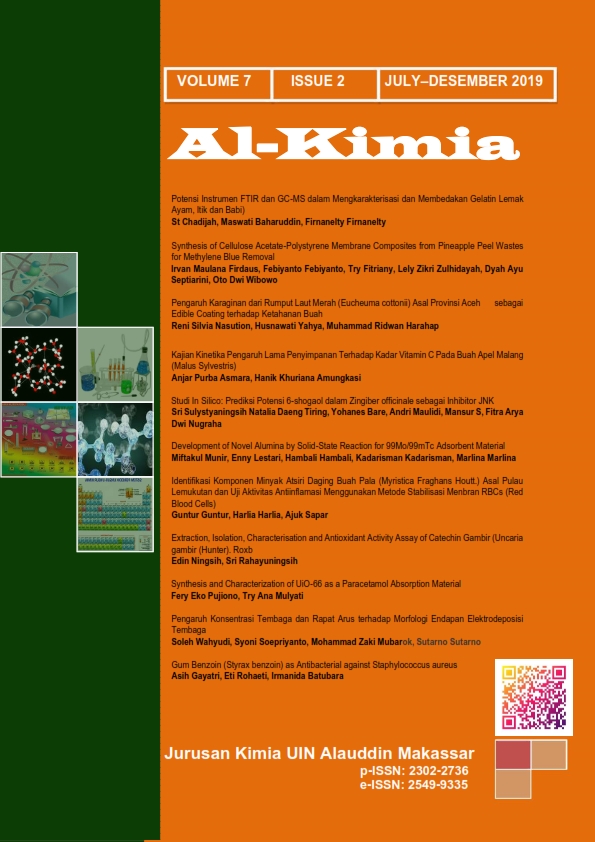Synthesis and Characterization of UiO-66 as a Paracetamol Absorption Material
Abstract
UiO-66 synthesis has been carried out by dissolving 0.53 grams of zirconium tetrachloride (ZrCl4) and 0.34 grams of Benzene-1,4-dicarboxylic Acid (H2BDC) in 30 mL Dimethylformamide (DMF). The solution is then distilled for 30 minutes and then heated in an oven at 140 ° C for 6 hours. The UiO-66 material produced was then characterized by an X-Ray Diffractometer (XRD) and Fourier Transform Infrared (FTIR). The results showed that the UiO-66 was successfully synthesized which supported the XRD results at 2θ 7.3o, 8.49o and 25.8o which were the peak characteristics of UiO-66. In addition, the FTIR results show a peak of around 1500 cm-1 showing vibrations of C = C on the benzene ring and a peak of about 1390 cm-1 indicating streching of O-C-O produced from the ligand. The peaks are around 750, and 660 cm-1 which indicates the presence of C-H vibrations from the ligand. UiO-66 was also approved as the adsorption agent of paracetamol which was approved with the highest adsorption of paracetamol at 72 hours immersion time which was 97.03%.
Downloads
References
Abid, H. R., Pham, G. H., Ang. H. M., Tade, M. O. and Wang, S. 2012. Adsorption of CH4 and CO2 on Zr-metal organic frameworks. Journal of Colloid and Interface Science, Vol.: 366, Hal.: 120–124
Chang, T., Wang, J., Ouyang, T., Zhang, Q., Jing, Y. 2015.
Photocatalytic Degradation of Acetaminophen in Aqueous Solutions by TiO2/ZSM-5 Zeolite with Low Energy Irradiation. Material Science and Engineering B. Vol.: 196. Hal.: 53-60.
Desale, A., Kamble, S. P., & Deosarkar, M. P. 2013. Photocatalytic Degradation of Paracetamol Using Degussa TiO2. Photocatalyst,International Journal of Chemical and Physical Sciences. Vo.: 2. Hal: 140-148.
Ilomuanya, M. O., Ohere, A. F., Zubair, S. A., Ubani-Ukoma, U. 2017. Evaluation of adsorption capacity of acetaminophen on activated charcoal dosage forms available in Nigeria by in vitro adsorption studies and scanning electron microscopy. Tropical Journal of Pharmaceutical Research. Vol.: 16(5). Hal.: 1105-1112.
Kandiah, M., Nilsen, M., H., Usseglio, S., Jakobsen, S., Olsbye, U. Tilset, M., larabi, C., Quadrelli, E. A., bonino, F., Lillerud, K. P. 2010. Synthesis and Stability of Tagged UiO-66 Zr-MOFs. Chemical Material. Vol.: 22. Hal.: 6632-6640.
Li, Q.L., Wang, J.P., Liu, W.C., Zhuang, X.Y., Liu, J.Q., Fan, G.L., Li, B.H., Lin, W.N., Man, J.H. 2015. A new (4,8)-connected topological MOF as potential drug delivery. Innorganic Chemistry Communication. Vol.: 55. Hal.: 8-10
Li, Z., Zhao, S., Wang, H., Peng, Y., Tan, Z., Tang, B. 2019. Functional Groups Influence and mechanism Research of UiO-66 type Metal Organic Frameworks for Ketoprofen Delivery. Colloids and Surface Biointerfaces. Vol.: 178. Hal.: 1-7.
Rahmawati, I. D., Ediati, R., Prasetyoko. 2014. Synthesis of UiO-66 Using Solvothermal Method at High Temperature. IPTEK Journal of Proceedings Series. Vol.: 1(1). Hal.: 42-47.
Schelling, M., Kim, M., Otal, E., Hinestroza, J. 2018. Decoration of Cotton Fibers with a Water-Stable Metal–Organic Framework (UiO-66) for the Decomposition and Enhanced Adsorption of Micropollutants in Water. Bioenginering. Vol.: 5(14). Hal.: 1-11.
Tai, S., Zhang, W., Zhang, J., Luo, G., Deng, M., Ling, Y., Jia, Y. 2016. Facile Preparation of UiO-66 Nanoparticles with Tunable Sizes in a Continuous flow Microreactor and Its Application in Drug Delivery. Microporous and Mesoporous Materials. Vol.: 220. Hal.: 148-154.
Trivedi, M. K., Patil, S., Shettigar, H., Bairwa, K. 2015. Effect of Biofield Treatment on Spectral Properties of Paracetamol and Piroxicam. Chemical Science Journal. Vol.: 6(3). Hal.: 1-6.
Wiratama, I. G. P., Ronaldi, H., Santoso, H. 2017. Pemodelan dan Simulasi Reaksi Degradasi Parasetamol Dengan Katalis TiO2. Jurnal Integrasi Proses. Vol.: 6(3). Hal.: 123 – 130.
Zhao, Q., yuan, W., Liang, J., Li, J. 2013. Synthesis and hydrogen storage studies of metal organic framework UiO-66. Hydrogen Energy. Vol.: 38(29) . Hal.: 1-6.
Copyright (c) 2019 Fery Eko Pujiono

This work is licensed under a Creative Commons Attribution-NonCommercial-ShareAlike 4.0 International License.
Authors who publish with this journal agree to the following terms:
1) Authors retain copyright and grant the journal right of first publication with the work simultaneously licensed under a Creative Commons Attribution License that allows others to share the work with an acknowledgement of the work's authorship and initial publication in this journal.
2) Authors are able to enter into separate, additional contractual arrangements for the non-exclusive distribution of the journal's published version of the work (e.g., post it to an institutional repository or publish it in a book), with an acknowledgement of its initial publication in this journal.
3)Authors are permitted and encouraged to post their work online (e.g., in institutional repositories or on their website) prior to and during the submission process, as it can lead to productive exchanges, as well as earlier and greater citation of published work (See The Effect of Open Access).


